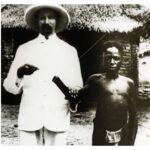
King Leopold’s primary motive was to extract as much wealth as possible from the Congo, particularly through the production of rubber.
To enforce his control and maximize profits, King Leopold imposed a reign of terror on the Congolese population. This photo mentioned captures a grim aspect of the brutality. Congolese individuals who failed to meet the demanding rubber production quotas set by the Belgian administration were subjected to severe punishment.
Thousands of Congolese were subjected to executions, including public hangings, or had their hands amputated as a means of punishment.
These cruel acts were carried out as a deterrent and as a means of maintaining control over the local population.
The atrocities committed during this period have been well-documented and are considered one of the darkest chapters in colonial history. In the photo, a child victim of these Belgian atrocities in the Congo is depicted alongside a missionary.
Missionaries played a complex role during this time, as some were complicit in the exploitative system, while others may have provided some level of humanitarian assistance.
The image serves as a haunting reminder of the profound suffering endured by the Congolese people under King Leopold’s oppressive regime.










Leave a Reply